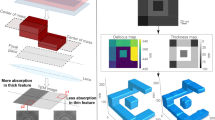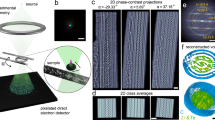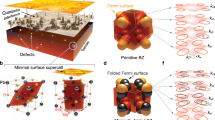Abstract
Until now it has not been possible to image at atomic resolution using classical electron tomographic methods1, except when the target is a perfectly crystalline nano-object imaged along a few zone axes2. The main reasons are that mechanical tilting in an electron microscope with sub-ångström precision over a very large angular range is difficult, that many real-life objects such as dielectric layers in microelectronic devices impose geometrical constraints and that many radiation-sensitive objects such as proteins limit the total electron dose. Hence, there is a need for a new tomographic scheme that is able to deduce three-dimensional information from only one or a few projections. Here we present an electron tomographic method that can be used to determine, from only one viewing direction and with sub-ångström precision, both the position of individual atoms in the plane of observation and their vertical position. The concept is based on the fact that an experimentally reconstructed exit wave3,4 consists of the superposition of the spherical waves that have been scattered by the individual atoms of the object. Furthermore, the phase of a Fourier component of a spherical wave increases with the distance of propagation at a known ‘phase speed’. If we assume that an atom is a point-like object, the relationship between the phase and the phase speed of each Fourier component is linear, and the distance between the atom and the plane of observation can therefore be determined by linear fitting. This picture has similarities with Big Bang cosmology, in which the Universe expands from a point-like origin such that the distance of any galaxy from the origin is linearly proportional to the speed at which it moves away from the origin (Hubble expansion). The proof of concept of the method has been demonstrated experimentally for graphene with a two-layer structure and it will work optimally for similar layered materials, such as boron nitride and molybdenum disulphide.
This is a preview of subscription content, access via your institution
Access options
Subscribe to this journal
Receive 51 print issues and online access
$199.00 per year
only $3.90 per issue
Buy this article
- Purchase on Springer Link
- Instant access to full article PDF
Prices may be subject to local taxes which are calculated during checkout




Similar content being viewed by others
References
Midgley, P. A. & Dunin-Borkowski, R. E. Electron tomography and holography in materials science. Nature Mater. 8, 271–280 (2009)
Van Aert, S. Batenburg, K. J., Rossell, M. D., Erni, R. & Van Tendeloo, R. Three- dimensional atomic imaging of crystalline nanoparticles. Nature 470, 374–377 (2011)
Coene, W., Thust, A., Van Dyck, D. & Op de Beeck, M. Maximum-likelihood method for focus-variation image reconstruction in high resolution transmission electron microscopy. Ultramicroscopy 64, 109–135 (1996)
Hsieh, W. K., Chen, F. R., Kai, J. J. & Kirkland, A. I. Resolution extension and exit wave reconstruction in complex HREM. Ultramicroscopy 98, 99–114 (2004)
Lehmann, M. & Lichte, H. Tutorial on off-axis electron holography. Microsc. Microanal. 8, 447–466 (2002)
Van Dyck, D. Wave reconstruction in TEM using a variable phase plate. Ultramicroscopy 110, 571–572 (2010)
Hubble, E. Effects of red shifts on the distribution of nebulae. Astrophys. J. 84, 517–554 (1936)
Hubble, E. A relation between distance and radial velocity among extra-galactic nebulae. Proc. Natl Acad. Sci. USA 15, 168–173 (1929)
Spence, J. C. H. High Resolution Electron Microscopy 3rd edn 61, 62 (Oxford Sci. Publ., 2003)
Bals, S., Van Aert, S., Van Tendeloo, G. & Avila-Brande, D. Statistical estimation of atomic positions from exit wave reconstruction with a precision in the picometer range. Phys. Rev. Lett. 96, 096106 (2006)
Jinschek, J. R., Yucelen, E., Calderon, H. A. & Freitag, B. Quantitative atomic 3-D imaging of single/double sheet graphene structure. Carbon 49, 556–562 (2011)
Reich, S., Maultzsch, J. & Thomsen, C. Tight-binding description of graphene. Phys. Rev. B 66, 035412 (2002)
Acknowledgements
We acknowledge discussions with A. Wang, S. Van Aert and I. Lobato. D.V.D. acknowledges financial support from the “Research foundation - Flanders (FWO)” under project nos G.0220.05 and G.0188.08. F.-R.C. would like to acknowledge the support from NSC-100-2120-M-007-005 and NSC-99-2120-M-007-008. J.R.J. thanks E. Yucelen, R. Dunin-Borkowski and Ch. Kisielowski for support, and N. Alem and A. Zettl for the gift of the graphene sample.’’.
Author information
Authors and Affiliations
Contributions
D.V.D. and F.-R.C. read and commented on the paper, and contributed equally to the work. J.R.J. provided the experimental images of graphene.
Corresponding authors
Ethics declarations
Competing interests
The authors declare no competing financial interests.
Supplementary information
Supplementary Information
This file contains Supplementary Text 1-2 and Supplementary Figures 1-2. (PDF 758 kb)
Supplementary Movie 1
This movie file shows the reconstructed tomography from Hubble analysis. It is a movie version for figure (b) and (c) of Supplementary Figures 1-2. (MOV 24837 kb)
Rights and permissions
About this article
Cite this article
Van Dyck, D., Jinschek, J. & Chen, FR. ‘Big Bang’ tomography as a new route to atomic-resolution electron tomography. Nature 486, 243–246 (2012). https://doi.org/10.1038/nature11074
Received:
Accepted:
Published:
Issue Date:
DOI: https://doi.org/10.1038/nature11074
This article is cited by
-
Unveiling the intricate moiré of moiré texture
Nature Materials (2024)
-
Machine learning in scanning transmission electron microscopy
Nature Reviews Methods Primers (2022)
-
Probing atom dynamics of excited Co-Mo-S nanocrystals in 3D
Nature Communications (2021)
-
Correlating the three-dimensional atomic defects and electronic properties of two-dimensional transition metal dichalcogenides
Nature Materials (2020)
-
Single-shot 3D coherent diffractive imaging of core-shell nanoparticles with elemental specificity
Scientific Reports (2018)
Comments
By submitting a comment you agree to abide by our Terms and Community Guidelines. If you find something abusive or that does not comply with our terms or guidelines please flag it as inappropriate.



